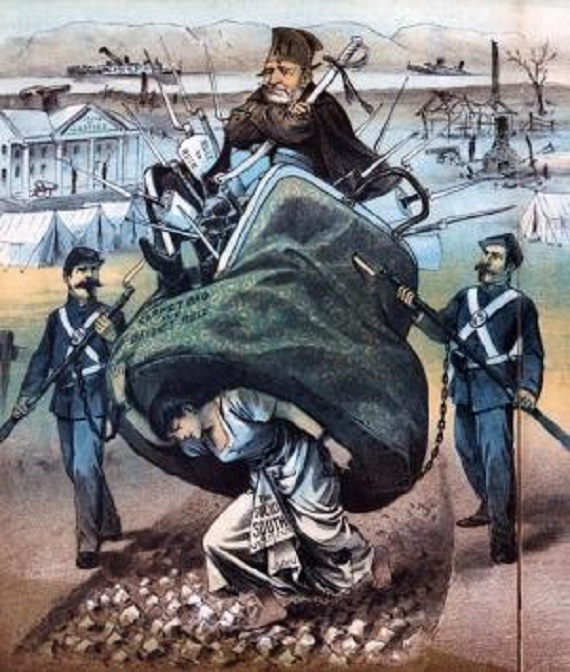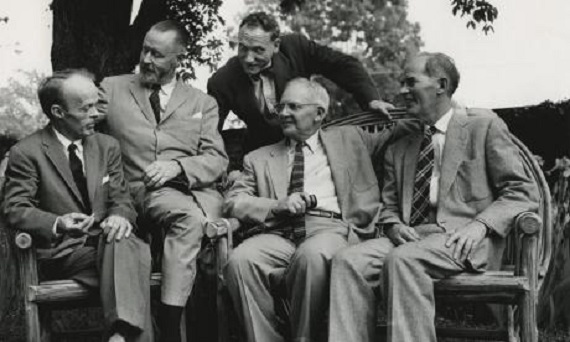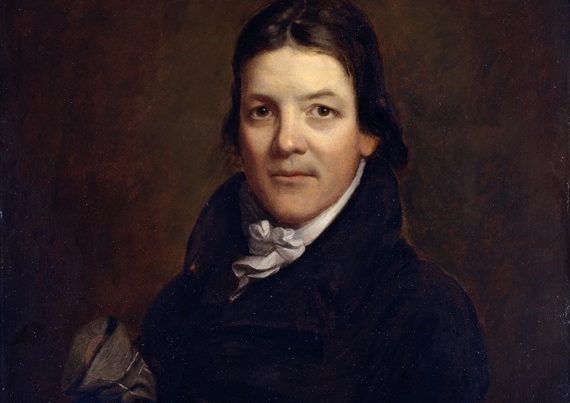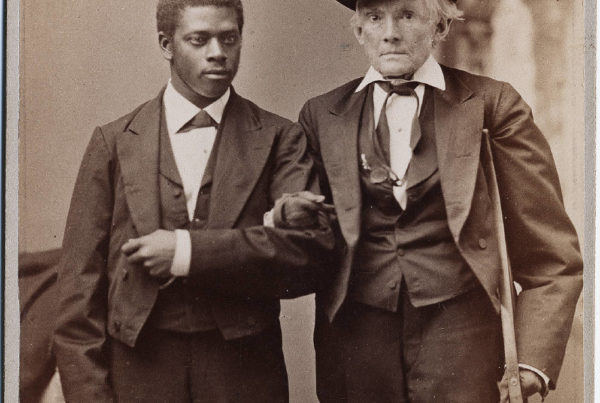Reconstruction. There is no part of American history in which what is taught these days is more distorted by false assumptions and assertions. For leftists, Reconstruction can be celebrated as a high point of revolutionary change and egalitarian forward thrust in American history. This interpretation is untrue in the terms in which they portray it, but that is the dominant, indeed only mainstream view today. This is the part of American history, then, that is most in need of honest understanding. You will be getting a lot of that this week. In fact, the scholars gathered here have things to teach about Reconstruction, both old things and new things, that cannot be heard anywhere else in the whole vast apparatus of American education.
First, the term “Reconstruction.” It does not refer to rebuilding. After World War II, the U.S. adopted what was called the Marshall Plan, by which we invested money to rebuild the infrastructure and living standards of the European nations, including defeated enemies. This was considered the decent and civilised thing to do, also that it might prevent future wars and retard any temptation towards Communist revolution. Reconstruction of the South did not in any sense constitute rebuilding. To the contrary, its main feature was to extract wealth from the already defeated and devastated Southern region. This was to be expected since the real reason for the war was to prevent the wealth of the South from escaping from control of the rich people of the North.
Reconstruction was a technical political term. It refers to “reconstructing” the political being of the United States; or more particularly “reconstructing” the Southern States that had been destroyed by the war into something more pleasing to the Republican politicians who had carried out the war. This is a rather peculiar thing, because the war on the South had been waged on the pretext of “preserving the Union.” But how could the Union be preserved by making war on a large part of it? By destroying by force the legal governments and the will of the people of thirteen States? Obviously the Union could not have been restored, much less preserved, under such circumstances. The War was a revolution which did not preserve the Union but destroyed the Union and substituted something else. In the wake of the Northern triumph the Southern States had to be wiped out and reconstructed on a basis other than the will of the people.
Reconstructing the South thus involved the ruling elements of the North in ignoring the Constitution entirely and in changing the rules of the game as it suited them in the process of restoring the States to the Union. I will develop this more in my second lecture on “Reconstruction as a Problem in Statesmanship.” In my third and last lecture I want to try to convey something of the nature of life under Reconstruction for the Southern people, both black and white.
Reconstruction refers to the period of American history from the end of hostilities until the withdrawal of the last federal troops from South Carolina, Florida, and Louisiana after the election of 1876. Actually, Reconstruction began as early as 1862 in the parts of the South occupied by the Union army—in particular southern Louisiana and Tennessee. The carpetbaggers, noncombatant opportunists, followed in the train of the army and began taking control and stealing well before the end of the war. This was especially true in Louisiana, which with sugar plantations and New Orleans trade, was the richest State—thus had the richest pickings for thieves. Reconstruction was brought to an end in each State at different times and under varying circumstances. By ending Reconstruction I mean that state governments were once more under the control of the people of the State rather than army officers, and the Southern States could once more send people of their own choosing to represent them in Congress rather than carpetbagger crooks chosen in stolen elections.
The term carpetbagger has been widely used for the Northerners who flocked South to control the government and make money. It was said that such people carried all their worldly possessions in a carpetbag—a cheap form of luggage. They were opportunists who had no standing in the Northern communities from which they came. This did not describe every Northerner who came South, but it was prevalent enough to be a stereotype. And of course stereotypes are such because they are true. It is a fact that people who had left the North under a financial cloud or even under indictment became wealthy and governors and U.S. Senators from the South. A good many of them were under indictment again at the end of Reconstruction when they got the first train North.
One thing to keep in mind is that the South is an immense area and that Reconstruction lasted for more than a decade. Every State and every locality and almost every family had a variant experience. A result of this is that you can find an incident or an example to support almost any point you want to make. But not every example that is presented is truly representative of the fundamental picture. Obviously the pervasive oppression of Reconstruction took different forms in South Carolina and Mississppi, which had a majority black population, than on the Texas frontier, or in Missouri and Tennessee where the struggle involved white Unionists rather than carpetbaggers and ex-slaves.
In studying Reconstruction this week, here is one reference point that might be referred to. History is a story. A story is somebody’s story. There are three different stories for Reconstruction, or perhaps better stated, there are three different protagonists—the white people of the South, the black people of the South, and the Republican party whose rule of North and South constituted Reconstruction. Of these, only the last had real power—the power to do as it pleased by military force without being hindered by any traditional ideas of law or justice. The white people of the South had only the power of resistance, in whatever way they could. The black people of the South were essentially pawns of the North. Everything that was done in regard to the black people, however celebrated now as progress toward freedom and equality, was done in the interest of the North. The current history tells a heroic tale of how the black people rose up as a great revolutionary, progressive force and claimed their rights. This is largely a fantasy. A small number of black leaders, mostly from the North and not ex-slaves, were cut in on the loot by the Republicans. But these leaders never served their own people and departed at the end of Reconstruction along with the white carpetbaggers to seek minor patronage jobs in Washington.
Reconstruction is very much a problem in historiography. That is, our understanding is dominated more by the interpretations created by various schools of historians than by a real knowledge of what happened. At first Reconstruction was viewed as no more than a just punishment for the evildoers who had defied Northern will. Towards the end of the 19th century the view had changed. The major Northern national historians of that period were all mightily convinced that the North had been right and righteous in making war to preserve the Union. But, being the first generation of professionally trained historians, who believed that they should try for objectivity and really investigate the sources for the truth, they had turned against Reconstruction. They recognised that Reconstruction had been an evil—because it involved immense corruption, because it based government on the votes of ex-slaves the vast majority of whom were unqualified, and because the Constitution had been over-ridden by a cabal of ruthless bad men who constituted for a time a revolutionary tribunal not responsible to the people or the law. This was the Congressional Joint Committee on Reconstruction under bad men like Thaddeus Stevens, Charles Sumner, and Benjamin Wade, along with Secretary of War Edwin M. Stanton, who was the nearest thing to a Heinrich Himmler who ever held high office in the U.S. The only demurrer from this was the history of Reconstruction by W.E.B. Dubois, who was a Communist from Harvard. He anticipated what has become the dominant interpretation in our time.
In the early 20th century there came the much derided “Dunning School” of historians, who are today dismissed unread because they were biased, racist Southerners. Actually, as I pointed out, Northern historians had already created the negative rendering of Reconstruction. William A. Dunning was a Northerner and a professor at Columbia University who wanted to establish a history of Reconstruction based upon research. Many of his students, the Dunning School, were Southerners. They were not the first to portray Reconstruction as a carnival of graft and ignorant rule. What they added were exhaustively researched studies of each State that documented chapter and verse the evil nature of what had been imposed on the South in the name of Reconstruction. These are still valuable studies, condemned unread as the product of Southerners, who all good people know without doubt are liars and oppressors.
You can still read Dunning studies and learn a great deal from them. J.G. de Roulhac Hamilton on North Carolina, Mildred Thompson on Georgia, William W. Davis on Florida, Walter L. Fleming on Alabama, and others.
Throughout the first half of the 20th century, the standard interpretation was that Reconstruction was a vindictive and counter-productive orgy of corruption and oppression. Such standard American history texts as the Oxford history by Samuel Eliot Morison of Harvard gave this account. Even extreme liberals who were highly critical of the segregated South in the 1950s and 1960s admitted that the evils of Reconstruction were partly responsible for the backward condition of the South.
Since the 1960s, coinciding with the Civil Rights Revolution and the dominance of extreme leftists in academia, we have had a new Reconstruction history. The history of Reconstruction by the Communist Eric Foner is the classic and sophisticated statement of this, although the interpretation is almost universally accepted as an unchallenged assumption.
According to this fantasy, which nowhere touches the lives of real people black or white, Reconstruction was a great revolutionary mission in which good Northerners and Southern black people sought full equality for black people. Indeed, some Radical Republicans talked this way, but it was never the main theme. Some progress was made, but the great move forward was finally ended when the North gave in to a terrorist reign of violence by Southern whites and abandoned its holy mission of racial equality, which was resumed only in the civil rights struggles of the 20th century. This tells the history of Reconstruction in the frame of Marxist romantic revolutionary mythology.
One of the tactics used is to play down the corruption of Reconstruction. It was not really so bad—and, after all, there was corruption in the North as well at the time. Well, yes, because the same crooks were controlling things in both the North and the South. The difference was that in the South they had complete control of local and state governments. But somehow corruption in the North excuses the carpetbagger looting of the South. The new historians also claim that the Reconstruction carpetbagger/black governments in the South made many progressive forward moves that the evil South had previously resisted. For instance, the establishment of public school systems. It is true that new constitutions called for such things and that money was appropriated. We must overlook the fact that in almost all cases most of the money was stolen. There were no viable public school systems in the South until after Reconstruction, when Southerners paid taxes to support both white and black schools despite their impoverished condition.
My assignment here is to provide an overview of Reconstruction. I must generalise about a very complex bundle of events and conditions. But let me throw out a few statements to keep in mind that characterise the period.
1. The great Commonwealth of Virginia, mother of Presidents and Mother of States, becomes Military District No. 1 in which civil government is entirely under the power of army officers in a time of peace. The relatives of George Washington, Thomas Jefferson, and Patrick Henry cannot vote, unlike newly freed slaves and any immigrant just off the boat.
2. Corruption. I mention examples of this here and there, but perhaps do not convey how pervasive it was. The evidence is overwhelming and unchallengeable. As an example, President Grant’s Vice-President, his Secretary of War, his brother-in-law, and several of his closest friends were exposed in huge scandals of graft and corruption. Also involved were leading Republican politicians James G. Blaine and James A. Garfield. Such was the atmosphere that it did not prevent them from being nominated by the Republicans for President. This mainly involved stealing from whiskey tax revenues in the North. It was much worse in the South.
Henry Clay Warmoth was from Wisconsin. He was chashiered from the Union Army. He became the Reconstruction governor of Louisiana. The governor’s salary was $8,000 per year. Every year that he was governor, he banked over $100,000 in income. The carpetbag/black legislature in South Carolina quadrupled taxes on the devastated people and spent more money for cigars and whiskey for itself than the entire state budget in 1860. All of the Southern legislatures gave immense sums to private corporations for railroads that were never built. Federal courts refused to allow these debts to be repudiated and South Carolina did not finish paying off the fraudulent carpetbagger debt until 1955. I could go on from now to Christmas without stopping with facts like these.
3. One of the tactics of Reconstruction was to mobilize the black people by promising them land. Sometimes it was to be their late master’s land, sometimes it was to be 40 acres and a mule for free. (Although 40 acres hardly made for a self-sustaining operation). The Republican operatives herding black voters in the South knew when they said this that it was a lie, that it would never happen. How low can you get? This was a standard tactic of Communists around the world who won the support of peasants by promises of land that they never intended to keep. In fact, the South Carolina legislature appropriated a large sum to buy land for the freedmen. It is estimated that it could have provided homesteads for 80,000 families—if 90 per cent of the money had not been stolen. The Reconstruction legislature in Georgia defeated an appropriation for the same purpose while voting millions to crooked corporations.
But consider this, which is almost never brought up. The U.S. government was at that very time giving away millions of acres of public land in the West, much of it to railroads and other corporations. Any Northerner or foreigner who made a show of settling on the land could receive a section of 640 acres free. But it never entered the minds of Northerners that any of this land should be made available to the freed slaves of the South. Among the strongest reasons for abolitionism, the war, and Reconstruction was to keep the black people in the South and out of the North.
4. By a two-to-one popular majority, Illinois in 1862 adopted a new constitution which forbade black people to enter the State. Lincoln’s friend and supporter Senator Trumbull remarked: “There is a very great aversion . . . against having free negroes come among us. Our people want nothing to do with the negro.” Shortly after, Secretary of War Stanton took note of the large number of ex-slaves who had gathered around the army at Cairo, Illinois, who were in a very sick and impoverished condition. He ordered them dispersed through Illinois, and in fact some rich Chicagoans had requested that choice blacks be sent to them as servants. Public meetings of protest were held all over Illinois and leaders, both Republican and Democrat, criticised the move. Defenders of the government assured the people that it was only temporary and after the war the blacks would be shipped back South. Salmon P. Chase of Ohio, abolitionist, member of Lincoln’s Cabinet, and later Chief Justice, expected that with emancipation “the blacks of the North will slide southward and leave no question to quarrel about.”
Governor John A. Andrew of Massachusetts was one of the strongest abolitionists before the war and supporter of the war on the South. In 1862, a Union general wrote to three New England governors asking them to take 2,000 ex-slaves who had attached themselves to the army. Governor Andrew responded that Massachusetts would be “a strange land and climate” for black people, in which they would “be incapable of self-help—a course certain to demoralise them and endanger others.”
About the same time, a Massachusetts colonel on duty wrote to the same Governor Andrew:
The thing we seek is permanent dominion: & what instance is there of permanent dominion without changing, revolutionising and absorbing the institutions, life and manners of the conquered peoples? They think we mean to take their slaves. Bah! We must take their ports, their mines, their water power, the very soil they plow. . . . we are to be a regenerating, colonising power. . . .
Here, I submit, is the true point to begin a study of Reconstruction.
SOURCE: From The Abbeville Summer School, July 2009.








World War I and the Reconstruction era are the two most misunderstood events (eras) in American History. Dr Clyde Wilson sets the record straight on Reconstruction of the South following the War for Southern Independence.